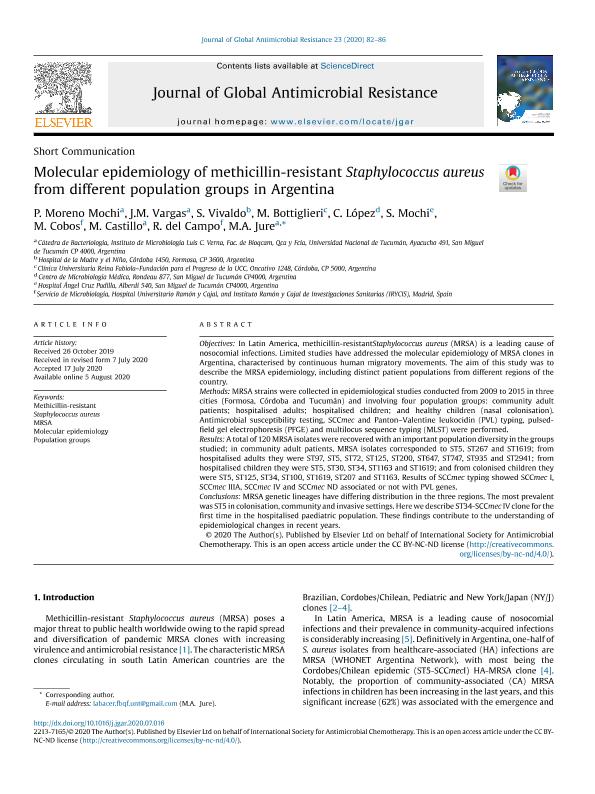Mostrar el registro sencillo del ítem
dc.contributor.author
Moreno Mochi, María Paula

dc.contributor.author
Vargas, Juan Martin

dc.contributor.author
Vivaldo, S.
dc.contributor.author
Bottiglieri, M.
dc.contributor.author
López, C.
dc.contributor.author
Mochi, S.
dc.contributor.author
Cobos, M.
dc.contributor.author
Castillo, M.
dc.contributor.author
del Campo, R.
dc.contributor.author
Jure, Maria Angela

dc.date.available
2023-11-21T16:16:37Z
dc.date.issued
2020-12
dc.identifier.citation
Moreno Mochi, María Paula; Vargas, Juan Martin; Vivaldo, S.; Bottiglieri, M.; López, C.; et al.; Molecular epidemiology of methicillin-resistant Staphylococcus aureus from different population groups in Argentina; Elsevier Ltd; Journal of Global Antimicrobial Resistance; 23; 12-2020; 82-86
dc.identifier.issn
2213-7165
dc.identifier.uri
http://hdl.handle.net/11336/218444
dc.description.abstract
Objectives: In Latin America, methicillin-resistantStaphylococcus aureus (MRSA) is a leading cause of nosocomial infections. Limited studies have addressed the molecular epidemiology of MRSA clones in Argentina, characterised by continuous human migratory movements. The aim of this study was to describe the MRSA epidemiology, including distinct patient populations from different regions of the country. Methods: MRSA strains were collected in epidemiological studies conducted from 2009 to 2015 in three cities (Formosa, Córdoba and Tucumán) and involving four population groups: community adult patients; hospitalised adults; hospitalised children; and healthy children (nasal colonisation). Antimicrobial susceptibility testing, SCCmec and Panton–Valentine leukocidin (PVL) typing, pulsed-field gel electrophoresis (PFGE) and multilocus sequence typing (MLST) were performed. Results: A total of 120 MRSA isolates were recovered with an important population diversity in the groups studied; in community adult patients, MRSA isolates corresponded to ST5, ST267 and ST1619; from hospitalised adults they were ST97, ST5, ST72, ST125, ST200, ST647, ST747, ST935 and ST2941; from hospitalised children they were ST5, ST30, ST34, ST1163 and ST1619; and from colonised children they were ST5, ST125, ST34, ST100, ST1619, ST207 and ST1163. Results of SCCmec typing showed SCCmec I, SCCmec IIIA, SCCmec IV and SCCmec ND associated or not with PVL genes. Conclusions: MRSA genetic lineages have differing distribution in the three regions. The most prevalent was ST5 in colonisation, community and invasive settings. Here we describe ST34-SCCmec IV clone for the first time in the hospitalised paediatric population. These findings contribute to the understanding of epidemiological changes in recent years.
dc.format
application/pdf
dc.language.iso
eng
dc.publisher
Elsevier Ltd
dc.rights
info:eu-repo/semantics/openAccess
dc.rights.uri
https://creativecommons.org/licenses/by-nc-nd/2.5/ar/
dc.subject
METHICILLIN-RESISTANT
dc.subject
MOLECULAR EPIDEMIOLOGY
dc.subject
MRSA
dc.subject
POPULATION GROUPS
dc.subject
STAPHYLOCOCCUS AUREUS
dc.subject.classification
Biología Celular, Microbiología

dc.subject.classification
Ciencias Biológicas

dc.subject.classification
CIENCIAS NATURALES Y EXACTAS

dc.title
Molecular epidemiology of methicillin-resistant Staphylococcus aureus from different population groups in Argentina
dc.type
info:eu-repo/semantics/article
dc.type
info:ar-repo/semantics/artículo
dc.type
info:eu-repo/semantics/publishedVersion
dc.date.updated
2023-11-21T11:45:55Z
dc.identifier.eissn
2213-7173
dc.journal.volume
23
dc.journal.pagination
82-86
dc.journal.pais
Países Bajos

dc.journal.ciudad
Amsterdam
dc.description.fil
Fil: Moreno Mochi, María Paula. Universidad Nacional de Tucumán. Facultad de Bioquímica, Química y Farmacia. Instituto de Microbiología; Argentina. Consejo Nacional de Investigaciones Científicas y Técnicas; Argentina
dc.description.fil
Fil: Vargas, Juan Martin. Consejo Nacional de Investigaciones Científicas y Técnicas; Argentina. Universidad Nacional de Tucumán. Facultad de Bioquímica, Química y Farmacia. Instituto de Microbiología; Argentina
dc.description.fil
Fil: Vivaldo, S.. Hospital de la Madre y El Niño; Argentina
dc.description.fil
Fil: Bottiglieri, M.. Universidad Católica de Córdoba. Facultad de Medicina. Clínica Universitaria Reina Fabiola; Argentina
dc.description.fil
Fil: López, C.. Centro de Microbiología Médica; Argentina
dc.description.fil
Fil: Mochi, S.. Gobierno de la Provincia de Tucumán. Hospital Ángel Padilla; Argentina
dc.description.fil
Fil: Cobos, M.. Hospital Ramon y Cajal; España. Instituto Ramón y Cajal de Investigaciones Sanitarias; España
dc.description.fil
Fil: Castillo, M.. Universidad Nacional de Tucumán. Facultad de Bioquímica, Química y Farmacia. Instituto de Microbiología; Argentina
dc.description.fil
Fil: del Campo, R.. Instituto Ramón y Cajal de Investigaciones Sanitarias; España. Hospital Ramon y Cajal; España
dc.description.fil
Fil: Jure, Maria Angela. Universidad Nacional de Tucumán. Facultad de Bioquímica, Química y Farmacia. Instituto de Microbiología; Argentina
dc.journal.title
Journal of Global Antimicrobial Resistance
dc.relation.alternativeid
info:eu-repo/semantics/altIdentifier/doi/http://dx.doi.org/10.1016/j.jgar.2020.07.016
dc.relation.alternativeid
info:eu-repo/semantics/altIdentifier/url/https://www.sciencedirect.com/science/article/pii/S2213716520301910
Archivos asociados
